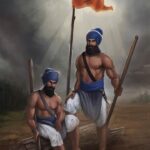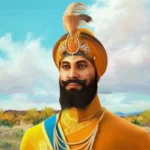Udham Singh (born Sher Singh; 26 December 1899 – 31 July 1940) was an Indian convert to the Ghadar Party and the HSRA, best known for assassinating Michael O’Dwyer, a former Punjab governor of India, on March 13, 1940. The assassination was carried out in retaliation for the Jallianwala Bagh at Amritsar in 1919, which O’Dwyer was facing. Singh was then convicted and convicted of murder and hanged in July 1940. While in custody, he used the name Ram Mohammad Singh Azad, representing the three major Indian religions and his anti-colonial sentiment.
Singh is a well-known figure in the Indian liberation movement. He is also known as Shaheed-i-Azam Sardar Udham Singh (“Shaheed-i-Azam” means “great martyr”). Uttarakhand district (Udham Singh Nagar) was named after him in October 1995 by the Mayawati government.
Early life
Udham Singh was born ‘Sher Singh’, on December 26, 1899, in the Pilbad area of Sunam, about 130 miles south of Lahore, British India, in Tehal Singh, Kamboj, a low-paid craftsman with his wife Narain. Kaur. He was their youngest, with a two-year difference between him and his older brother, Sadhu. [5] When they were three and five years old, their mother died. [5] The two boys then became close to their father while he was working in the village of Nilowal carrying mud from a newly constructed canal, which is part of the Punjab Canal Colonies. After his dismissal, he was offered a job as a railway guard in the village of Upali.
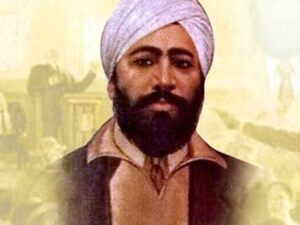
In October 1907, while walking boys in Amritsar, his father collapsed and died at Ram Bagh Hospital. [5] The two siblings were then handed over to an uncle who could not keep them and was handed over to the Central Khalsa Orphanage, where, according to the orphanage registration, they started work on October 28. [5] After his baptism, Sadhu became “Mukta”, meaning “one who has escaped from reincarnation,” and Sher Singh was renamed “Udham Singh”, and Udham meaning “chaos”. In the orphanage, he was affectionately called “Ude”. In 1917, Mukta died of a sudden unexplained illness. Shortly thereafter, despite being under the official age of registration, Udham Singh persuaded the authorities to allow him to serve in the British Indian Army during World War I. He was then assigned to the lower level staff and 32 Sikh Pioneers to work on rehabilitating the railway line up to Basra. His age and conflict led him to return to Punjab in less than six months. In 1918, he rejoined the army and was sent to Basra and Baghdad, where he worked as a carpenter and regular maintenance of machinery and vehicles, returning a year later to the Amritsar orphanage in early 1919.
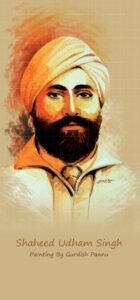
On April 10, 1919, several local leaders who had joined the Indian National Congress, including Satyapal and Saifuddin Kitchlew, were arrested under the provisions of the Rowlatt Act. A mob stormed the protest, causing a riot that saw many European-owned banks attacked and a few Europeans on the streets.On the 13th of April, more than 20,000 unarmed people gathered in Jallianwala Bagh, Amritsar to celebrate the important Sikh festival of Baisakhi, and to protest peacefully against the arrest. Singh and his friends from the orphanage provided water for the crowd. Soldiers under the command of Colonel Reginald Dyer opened fire on the crowd, killing several hundred; this is variously known as the Amritsar Massacre or the Jallianwala Bagh massacre.
Singh became involved in revolutionary politics and was deeply influenced by Bhagat Singh and his rebel group. In 1924, Singh joined the Ghadar faction, placing Indians overseas to overthrow the colonial empire. In 1927, he returned to India at the command of Bhagat Singh, bringing with him 25 friends and pistols and ammunition. Shortly after that, he was arrested for possession of an illegal weapon. Guns, ammunition, and copies of a banned Ghadar Party paper called “Ghadr-di-Gunj” (“Voice of Revolt”) were confiscated. He was prosecuted and sentenced to five years in prison.
Upon his release from prison in 1931, Singh’s movements were regularly monitored by Punjab police. He headed for Kashmir, where he managed to escape from the police and fled to Germany. In 1934, he arrived in London, where he got a job as an engineer. On the other hand, he is plotting to assassinate Michael O’Dwyer. In Singh’s diary of 1939 and 1940, he occasionally spells O’Dwyer’s surname as “O’Dyer”, leaving the possibility of confusing O’Dwyer with General Dyer. In England, Singh was a member of the Indian Workers’ Association in Coventry and attended their meetings.
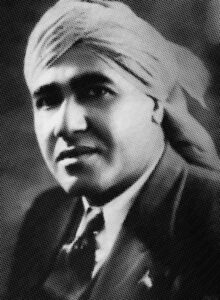
Shooting at Caxton Hall
On March 13, 1940, Michael O’Dwyer was scheduled to address a joint meeting of the East India Association and the Central Asian Society (now the Royal Society for Asian Affairs) at Caxton Hall, London. Singh hid a pistol in a notebook, which contained pages cut out like a pistol. This pistol was purchased by him from a soldier in a shebeen. He then entered the hall and found an open seat. When the meeting ended, Singh shot O’Dwyer twice as he approached the speaking area. One of the bullets passed through O’Dwyer’s heart and right lung, killing him almost instantly.
Murder, trial, and execution
Singh (second from left) taken to Caxton Hall after the assassination of Michael O’Dwyer
On April 1, 1940, Singh was officially charged with murdering Michael O’Dwyer and was held in a Brixton prison cell. When initially asked to explain his reasons, Singh said: “I did it because I was angry with him. It should. What good is it to wait until you are old … If Zetland was dead I should have put two of them in and bought a soldier’s revolver at a public house, my parents died when I was three or four years old. Only one dead? I thought I could get more. ”
During his imprisonment, he called himself Ram Mohammad Singh Azad: the first three names of the three Punjab religious communities (Hindus, Muslims, and Sikhs); the last word azad (literally “free”) reflects his anti-colonial sentiment.

